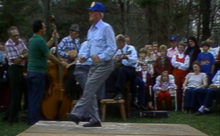Talking Feet Project Methods
From the very beginning, this project was limited in budget and scope. Because of this, we relied largely on recommendations from advisors familiar with traditional solo dancing of the southeastern United States.
Ideally, several months, rather than several weeks, of field work would have been required to do original research and properly survey solo dance in the small area of the four states represented here. Finding old-time dancers is much like searching for old-time ballad singers or banjo pickers. While some dancers will come out to public music-making, a lot of the more traditional, home-style dancers are more informal and private with their dancing. The reason that most of the dancers we recorded are from North Carolina is not only that there are a great number of good dancers there, but also because their dance activities are more visible and organized. Research and presentation by folklorists and informal collectors over the years have certainly played an important part in the life of these traditions, as well as in this project.
We tried to choose music in consultation with the dancers. In a few cases, we show our dancers using music they danced to for the first time, with no rehearsal-most notably, Algia Mae Hinton (dance with banjo), Phoebe Parsons, John Reeves, L.C. King, and the Fiddle Puppets.
We asked our dancers to use the shoes that they had used traditionally. We favored the use of regular, not tap, shoes and in only one case, with Biddie Reece, did we especially request regular shoes. Mrs. Reece had recently started using taps on her shoes. Burton Edwards chose to use soft shoes. D. Ray White preferred to use taps for most of his dancing.
In our filming, we asked our cameraman to film our dancers full length, head to toe, with a little to spare. It was also our intention to use an absolute minimum of "cutaways" (shots of different scenes or from different angles) which might detract from the continuity of the performance.
During our interviews we tried to cover these questions and subjects:
Date and place of birth
How, where, when and from whom they learned
Other family/community members who danced
What terms they use to name their dance or dances
Names for separate steps
Ideas about dance names
When they first heard the term "clog"
If their style changed over the years
Favorite music, instrument
Dance to "patting" or other such sounds?
Do animal dances or other imitations?
Dance barefoot?
Preferred type of shoes
Preferred tempo
Stories about dancing
Competition in dance
Where these dances come from
Why they dance
What elements of their dance are important
The occasions and context for dance
The connection of "step" dancing and called figure dancing
The issue of some churches forbidding dance
Comparisons between men's and women's dance
The issue of European/African influences in dance
We have included most of the important material from the interviews so that the less casual viewer might understand better the hows and whys of traditional dance. There is some similarity of experience, some repetition from dancer to dancer, just as there is in dance itself. But each dancer has a different story to tell and a different way of telling it. After reading these notes one should be better able to understand traditional dance: how it was, how it has been evolving and, to some extent, where it is today.
